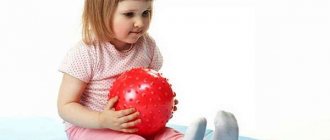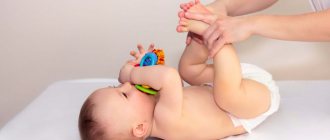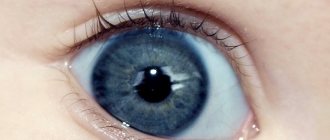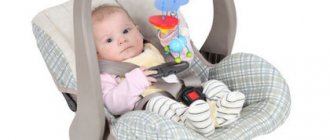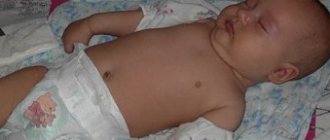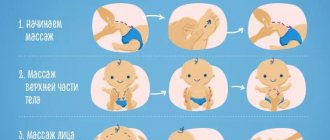Baby massage is a wonderful way to express love and care. It also calms and helps your baby sleep. Undoubtedly, you and your significant other will find a pleasant and relaxing holiday in a massage!
Baby massage is a gentle, rhythmic stroking of the baby's body with your hands. You need to massage his ankles, wrists and fingers.
Massage movements stimulate the appearance of the good mood - oxytocin - not only in mothers and their children, but also in fathers who observe this process. Oxytocin is a hormone that gives feelings of warmth and love.
Benefits of baby massage
Massage is especially beneficial for premature babies, helping them grow and develop healthy. It also has a positive effect on babies who were born on time without complications.
helps:
- - strengthen the bond between mother and child;
- - stay relaxed and don’t get upset over trifles;
- - reduce the desire to cry;
- - better sleep
The study showed that the use of baby massage reduces the number of diseases that often affect children at an early age. There is also a theory that touch and skin-to-skin contact helps stimulate brain development.
Giving a massage to a child lifts his mood and helps him feel like a sensitive mom or dad. By setting aside a special time to massage your baby, you will be surprised how this period of time becomes special and precious.
When you massage, this means that you communicate naturally with your child, maintaining eye contact. This is one of the reasons why the process will help mothers overcome postpartum depression.
Dads will also feel the positive benefits. Some fathers miss this social contact, especially when they spend a lot of time at work. Regular baby massage at home will become routine for dad.
Baby massage
History of massage Types of Massage Manual therapy Children's massage Sports massage Tools Creams, oils, gels Indications Quotes, aphorisms License Price
Preventive massage promotes the harmonious physical and emotional development of the baby.
1. Why do babies need massage? 2. Why does a child need massage after 1 year? 3. Why does a preschool child need a massage? 4. Why does a school-age child need a massage?
Massage is not only a way of relaxation. This is a whole complex of mechanical and reflex effects on the human body. Using a variety of techniques: rubbing, pressure, vibration, you can achieve both therapeutic and general healing effects, maintain muscle tone, and develop them.
Massage is especially necessary for children. For newborns, it is an integral part of daily care procedures, as it has a positive effect not only on the condition of the skin, but also on the musculoskeletal, nervous and cardiovascular systems of the baby’s body. We are talking about both absolutely healthy guys and those who have any problems. Therapeutic and preventive massage is prescribed by a pediatrician for certain symptoms and is performed strictly by a specialist to help cope with existing diseases. For healthy children, massage is a set of activities that promotes the proper development of motor skills, strengthening muscles, nervous and immune systems.
Depending on the age of the child, massage can achieve different goals.
Why do babies need massage?
Preventive massage is indicated for ALL children in the first year of life. This is so important for healthy children because:
- Due to the physical effect on the skin, a whole stream of impulses goes from the peripheral nervous system to the brain. This promotes mental and psychological development.
- Blood circulation improves, tissues are saturated with oxygen.
- Abdominal massage promotes the release of gases, strengthens the abs and helps improve the digestion process.
- It will provide an opportunity to overcome the hypertension inherent in all newborn children.
Massage is especially indicated for children with poor appetite, sedentary, premature babies, children on artificial feeding, and with weakened muscles. In such cases, massage to the child is carried out for medicinal purposes. Most often, with its help, the following problems are solved in children under one year of age:
- Congenital torticollis.
- Dysplasia.
- Scoliosis.
- Distortion of the pelvic bones.
- Disturbances in the functioning of the nervous system: excessive muscle tension, incoordination of movements and other problems.
Why does a child need massage after 1 year?
Children after a year, when they become more mobile, should combine massage with gymnastic exercises. This will prepare the baby for mastering further complex actions.
Massage for children after one year is somewhat different from a similar procedure for infants. Their skin thickens significantly, which means the technique is modified. You can include techniques such as: tapping, vibration, rubbing.
If the child is healthy, then the purpose of the intervention will be:
- Relaxation before going to bed. Relieving tension both from the whole body and from a separate part of it.
- Warming up the muscles, saturating the tissues with oxygen.
- Improving intestinal motility.
- Decreased nervous excitability.
Sometimes more global problems are solved with the help of massage, and then it is therapeutic in nature:
- Treatment of flat feet and club feet, as well as other problems with the musculoskeletal system (according to doctor’s indications).
- Comprehensive treatment of neurological disorders.
- Diseases of the lungs and bronchi, for better sputum discharge.
Combining all the techniques with certain gymnastic exercises will make it possible to obtain a more pronounced effect. Physical therapy is often used.

Why does a preschool child need a massage?
Massage for children from 2.5 to 7 years old can include a wide variety of techniques. For healthy guys, massage is needed to relieve tension from the muscles and saturate the tissues with oxygen. Acupressure will help strengthen children's immunity. In addition, massage can be an excellent way to develop speech, thinking and imagination. A general wellness massage should be combined with special chants, poems, and nursery rhymes. Depending on the purpose of the event, to calm or, on the contrary, warm up the muscles, you should choose different times of day and intensity of exposure. In any case, massage will help improve the outflow of lymph and blood circulation of the child.
When a massage is prescribed by a doctor to treat certain diseases, then it should be done by a specialist. As a rule, this is a whole course consisting of various procedures. Its purpose may be treatment and prevention:
- Flat feet.
- Strengthening a specific muscle group.
- Complex therapy of inflammatory diseases (bronchitis, laryngitis, cystitis, gastritis, pneumonia).
- Correction of posture (kyphosis, scoliosis, stoop, flattening of the spine) and other indications.
- Speedy recovery from injuries (dislocations, fractures, cracks).
- Acquired torticollis, reduction of vertebrae.
Why does a school-age child need a massage?
For school-age children, massage is carried out according to doctor's indications. The same problems are solved as for preschoolers: diseases of the musculoskeletal system, neurological problems, weakened immunity, etc. However, adolescents can perform some elements independently.
In addition to the main therapeutic goal, certain massage courses will contribute to:
- Improved sleep.
- Relieving muscle and nervous tension.
- Increased appetite and immunity.
- Improving academic performance.
Massage is important for a child at any age. Depending on the purpose of its implementation, it can be carried out either by a specialist or by parents at home.
The child’s body develops all the time and, in the nature of its responses to various external influences, differs from the adult’s body. Currently, none of the leading specialists has any doubt that preventive massage is a necessary element of child care, as well as the most important component of its subsequent development.
=class"font19">
Feedback
When to massage your baby
Try to choose the time between feedings, then the baby will not feel too hungry. Also, do not start a massage immediately before bed. The best thing is when the little one is calm and getting ready for bed.
Make it a habit to massage your baby after bathing or feeding her at night. Before bed will help relieve stress, relax and calm down after a stormy day. And only after it the baby will be ready for a sound sleep.
What you need before a massage
Make sure the room is warm and free of drafts. Then place the baby on a towel or sheet, you can put a bedding for more softness. If the room is a little cool, put a shirt on your baby. But for a change, don't take away the opportunity to enjoy being naked.
Make sure there are no distractions in the room. If you have a pet, lock it in another room. Also turn off your mobile phone. Turn on relaxing, quiet music.
What you need for baby massage:
- - baby oil;
- - a towel to wipe off some remaining oil;
- - clothes to wear immediately after the procedure;
- - clean diaper.
Using an oil or cream to make it easier for your hands to glide over baby's skin is also a great way for baby to relax. You can choose to use baby moisturizer, vegetable or mineral oil.
Be sure to apply a small amount to a small area of skin first to see if any negative reaction occurs. However, there are some creams that it is better not to use, as there is a chance of severely irritating children's skin. These include:
- — mustard oil, since during its processing contaminated seeds may get in;
- - peanut butter. If it is not purified, the proteins it contains may cause an allergic reaction. Pure and refined peanut butter is difficult to find;
- - liquid cream. Contains detergents that may irritate children's skin
- If your baby has eczema, you should be prescribed a special cream.
SOME EXERCISES TO HELP DEVELOP A SENSE OF BALANCE
do not be afraid to carry your baby in your arms in different positions: on your right and left arm, with your face and back to you, change his position in the crib more often. The following exercises are effective for training the vestibular system: swaying in the fetal position, swaying on a ball with your stomach and back down. Rocking in your arms - taking the child in your arms facing you and supporting him under the back, rock the baby up and down (toward and away from you), taking the child in your arms in a vertical or horizontal position, spin with him in both directions. Horizontal spinning - stand up, put the baby on your shoulder, belly down, start spinning, but do it carefully enough so as not to lose balance, change the direction of the spinning - either clockwise or counterclockwise, and then spin the child, holding him on his side, repeat spinning, shifting the baby to the other side, spinning with the baby, lift him into the air and spin with him again, before finishing, lower the child down almost to the floor and lift him up again, start the exercise slowly and carefully, if for some reason For some reason your newborn doesn’t like something, then most likely you are acting too quickly, slow down. Gradually increase the time of practice from ten to fifteen seconds for each exercise to thirty to forty, always stop before your child wants. Rocking - try rocking the child in a vertical position up and down, lifting him into the air and lowering him with his legs onto your stomach, this will not only give him pleasure, but will also provide training for the support of his legs, lie on his back and swing the child above you, grab him tightly by the sides under your arms, lift them above you and look into each other's eyes, tell him that he is an airplane, gently swing him left and right, lower him onto your chest and lift him again, rock the baby on your lap, sitting him on one or the other to another. Rolling with a log - with both hands, put the baby on his side, and then roll further, moving behind him, then roll him to the other side and help him return to the starting position on his own; when your child learns to roll independently several times in a row, ask him to roll on both sides sides. Pushing - If the child is standing firmly on all fours, lightly push him forward, back, to the sides, the exercise is carried out in the form of a game, encouraging the child to stay on all fours. Swinging with a baby in your arms, on a swing, in a hammock, on a carousel, later let the child swing on his own, you just need to secure him. Spin by the hands - turning the child to face you, take him by the wrists and spin him on straight arms, spin first in one direction, then in the other. Acceleration - turn the child towards you and take him under your arms, throw him low into the air and catch him, usually kids really like this exercise, thanks to it the child feels the force of gravity, especially at the moment when he falls into your hands. Swinging head down (for the bravest parents) - grab the child tenaciously by the ankles and lift him up, it is better if he is facing you, start gently, like a pendulum, swing him from side to side, when you lower the baby, be especially careful, take care of your neck. Parents sometimes feel fear at the mere thought of having to hold the baby head down, but this position is familiar to every newborn, in a normal pregnancy the baby is turned upside down in the last month whenever the mother is standing or sitting, so be brave, play more actively with your baby, change the position of his body in space more often.
How to properly massage a child
Of course, you can follow the usual pattern - first the arms, then the legs, and finally all the other parts of the body. The child will appreciate this order of movements. The baby will be comfortable knowing what will happen next. The first few times, just start by massaging the legs until the baby gets used to such sensations.
To learn this procedure, ask your pediatrician which clinics and children's centers to visit to take courses. If you want to quickly start massaging your baby, read the following steps and follow this pattern:
- - first heat a small syringe with oil or cream with your hands, rubbing it with your palms;
- - Gently rub the oil into the skin, starting from the legs. This is the best place to start as your baby is used to this kind of touching during diaper changes;
- — start massaging your legs, lightly squeezing your calves and thighs;
- - To begin massaging your baby's chest and tummy, gently place both hands in the center of the body. Move your hands around with stroking movements, as if you were aligning the pages in a book;
- - with straightened palms, begin to stroke your tummy with your fingertips in small circular movements;
- - continue to do this as long as you see that the baby is happy with the process;
- - the ability to recognize various behavioral cues is an important aspect. The child will immediately let you know which movements he likes or vice versa. If he starts crying, he tells you that it’s time to finish.
How to do a massage correctly
First, prepare the room in which you massage your one-month-old baby. It is advisable to ventilate the room and then heat the air in it to a comfortable temperature of 20–22 degrees. During the massage, the baby will be pleased if the mother shows love and affection by smiling at the baby, talking to him, and singing songs.
Perform massage in between feedings and bedtime, making sure that at least 30 minutes pass after eating.
Place the baby on a changing table or any flat surface covered with a soft natural cloth. Start performing the massage when the baby is in a great mood, so your month-old baby will quickly get used to the new movements and will soon react positively to them. Perform the exercises with thoroughly washed, warm hands, soften your palms with oil, or if you have an allergic reaction to it, use baby powder.
For an infant
The right time to start performing light massage on a newborn is two weeks to a month from the moment the baby is born. Do not forget to consult your pediatrician first and make sure that you do not have any contraindications. The normal frequency with which a mother can independently massage her month-old baby is daily, or once every two days.
Watch a video with a detailed description of massage techniques for children under one year old, pay attention to the key points. When massaging the skin of your one-month-old baby, try not to force yourself, use gentle and light massage movements. Start movements from the legs to the chest. A one-month-old baby will benefit from a tummy massage, which improves the process of digestion of food. Massage your baby's tummy in a circular motion, and only clockwise.
Important: when massaging the back of a newborn, avoid the spine area, bypass the axillary lymph nodes, as well as the area of the heart and liver.
Newborn
In the first month of life, massage encourages children to perform independent movements. Therefore, it is necessary to relax the flexor muscles of the legs and arms in order to reduce hypertonicity, which is often expressed in children from birth to the first month of life.
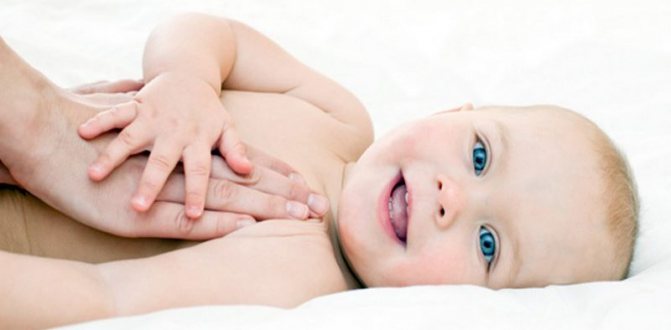
Wait for your baby to be in a good mood. He should not experience feelings of hunger, thirst, temperature discomfort, etc. Establish trusting contact with the baby. Be careful when choosing massage techniques. Start with light, gentle movements that do not cause pain or other discomfort in your one-month-old baby. Massage your baby's heels and feet, stretch your toes. Make rotational movements of the foot in one direction and the other. Stroke the shin from the foot to the knee, apply pinching and pressure.
Control your movements and pressure. Remember, you are only stretching your muscles and joints.
When massaging the thigh of a newborn toddler, avoid the inner surface area. When finishing massaging one area and moving on to another, do not forget to do light stroking. After this, proceed to massage the tummy clockwise. Use light pressure to stretch your pectoral muscles. Remember, when massaging we avoid the heart zone.
We stretch the arms in the joints, gradually complicating the exercises and increasing the range of movements.
Then we turn the baby from his back to his tummy. Gently stroke, rub and knead the back muscles along the spine, without touching it, the back surface of the buttocks, thighs, and legs. The direction of massage movements is from the head to the legs. To prevent flat feet in a newborn, run your index finger over each foot 2-3 times.
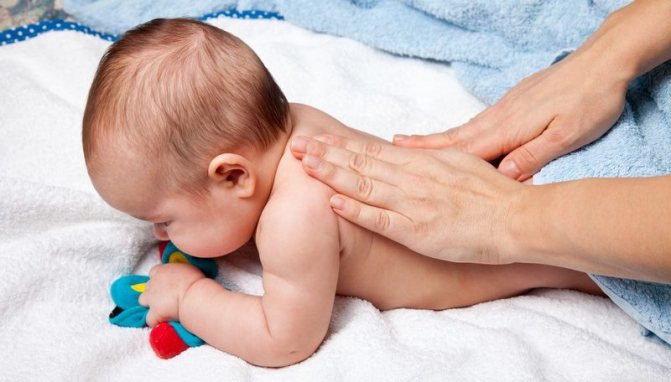
Children up to six months
At the age of 3 months, the child is already accustomed to his mother’s massage. The gentle touches with which you began your acquaintance with massage techniques become more intense. It is the stroking that prepares the baby’s skin for rubbing, and the intense movements of the hands prepare the baby’s body for kneading. When performing these movements, we will have an impact not only on the baby’s skin, but also use the muscles.
Stroking, rubbing and kneading the arms, legs, back, and tummy wonderfully prepare the child’s body for light gymnastics. We start with kneading, then perform sliding movements of the baby’s feet on the surface of the massage table. Thus, we educate the support reaction.
At about four to five months, we begin to train the baby to turn from back to tummy, first to the right, then to the left. Holding the baby by the hand, we throw one leg behind the other, and the child makes a revolution on his own. Active rollovers train the muscles of the neck and shoulder girdle; we remind you that gymnastic movements should be performed if the child is in a positive mood, does not resist and does not cry.
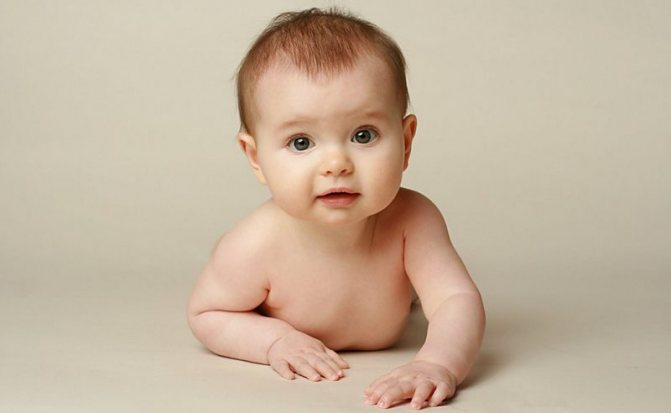
Children from six months to one year
After six months, your child is ready to sit and stand independently with support. There is a chance that he is already sitting down on his own and with pleasure and standing, holding onto the support with his hands. These two important motor skills require significant physical preparation. It is necessary for those muscles that are involved in maintaining the vertical position of the child’s body to become stronger. During this period of life, babies actively crawl, stimulated by a toy in their field of view.
Perform a massage on a child aged 6 months often and clearly pronouncing the same words, calling on the baby to perform this or that action, for example, “sit down”, “get up”.
A difficult exercise to perform, requiring complex coordination of movements, but effective, strengthening the back muscles of a child up to one year old will be bending forward from a standing position with his back to the mother (we recommend watching a video on how to perform this exercise correctly). Use objects that attract attention, toys, balls for bending. When performing this exercise, securely fix the child's legs, pressing them towards you.


